Special Report
States Where Welfare Supports the Fewest Poor Families

Published:
Last Updated:

The share of poor families who receive welfare in the United States through the Temporary Assistance for Needy Families program (TANF) has fallen dramatically in the last 20 years. Today, most poor families do not receive welfare.
The 1996 overhaul of the U.S. welfare system introduced TANF — block grant funds from the federal government that gave states greater discretion over the distribution of these resources. Since then, the proportion of needy families receiving cash assistance nationwide has fallen from 68 in every 100 families living in poverty to just 23 in 100 in 2015. The decline can be partially attributed to budgetary decisions by state officials under the relatively flexible TANF rules. Also, because the block grant has not been adjusted for inflation, it has lost a third of its value since it was introduced.
24/7 Wall St. reviewed the TANF-to-poverty ratio — which measures the number of families receiving benefits for every 100 families living in poverty — in every state from the Urban Institute. In its May 2017 report, “Why Does Cash Welfare Depend on Where You Live?,” the policy think tank analyzed data from the government and a variety of other sources.
In an interview with 24/7 Wall St., Heather Hahn, senior fellow at the Urban Institute and lead author of the research report, said, “States are under no obligation to provide assistance to anyone.” Due primarily to such factors as political culture, budget considerations, eligibility rules, and according to Urban Institute’s findings demographics, provisions for needy families under the TANF welfare program vary dramatically by state.
Click here to see the states where welfare supports the fewest poor families.
Click here to see the states where welfare supports the most poor families.
Click here to see our detailed findings and methodology.
States Where Welfare Supports the Fewest Poor Families

10. Indiana
> TANF-to-poverty ratio: 8 for every 100 poor families
> Median household income: $50,532 (16th lowest)
> Maximum income for initial eligibility: $378 (5th lowest)
> Maximum monthly benefit: $288 (12th lowest)
Only about eight out of every 100 Indiana families living in poverty receive cash benefits from TANF, versus the national proportion of 23 in 100 needy families. In keeping with the national trend, the share of TANF beneficiaries has dropped dramatically over the last two decades. The share of poor families benefitting from basic cash assistance in Indiana is down from 61 for every 100 in 1996.
Like many other states where welfare supports the fewest families, Indiana’s welfare system is not especially generous. For example, a family struggling to make ends meet in Indiana can only receive benefits under the TANF program for a maximum of 24 months, one of the lowest such limits of all states.
[in-text-ad]

9. North Carolina
> TANF-to-poverty ratio: 8 for every 100 poor families
> Median household income: $47,830 (10th lowest)
> Maximum income for initial eligibility: $681 (22nd lowest)
> Maximum monthly benefit: $272 (7th lowest)
While TANF rules apply to everyone the same regardless of race, states with less generous and more restrictive TANF policies tend to have larger African Americans populations. North Carolina is no exception. Nearly 22% of the state’s 10million residents are black, one of the largest shares of any state and well above the comparable 13% share of the U.S. population.
As is generally the case, the modest benefits available to needy families in the state are nowhere near enough to alleviate poverty. The maximum benefit a poor family can receive is $272 a month, seventh lowest of all states. Only 9.2% of the state’s total TANF spending is in the form of cash payments, one of the smallest shares of any state and well below the 24.6% national share.

8. Arizona
> TANF-to-poverty ratio: 8 for every 100 poor families
> Median household income: $51,492 (20th lowest)
> Maximum income for initial eligibility: $585 (16th lowest)
> Maximum monthly benefit: $277 (10th lowest)
Some 17.4% of Arizona residents live in poverty, one of the largest poverty rates of any state and well above the 14.7% national poverty rate. Of the state’s families with children living below the poverty line, only about eight in 100 receive welfare benefits, down from 42 out of 100 in 1996, and 29 per 100 in 2001. In neighboring California, 65 out of every 100 families with children living in poverty receive cash benefits from TANF.
Cash assistance is one of the core spending goals of the TANF block grant. Yet in Arizona it accounts for only about 6% of the $468.9 million spent under the welfare program, the second smallest share of any state and well below the 25% national share.
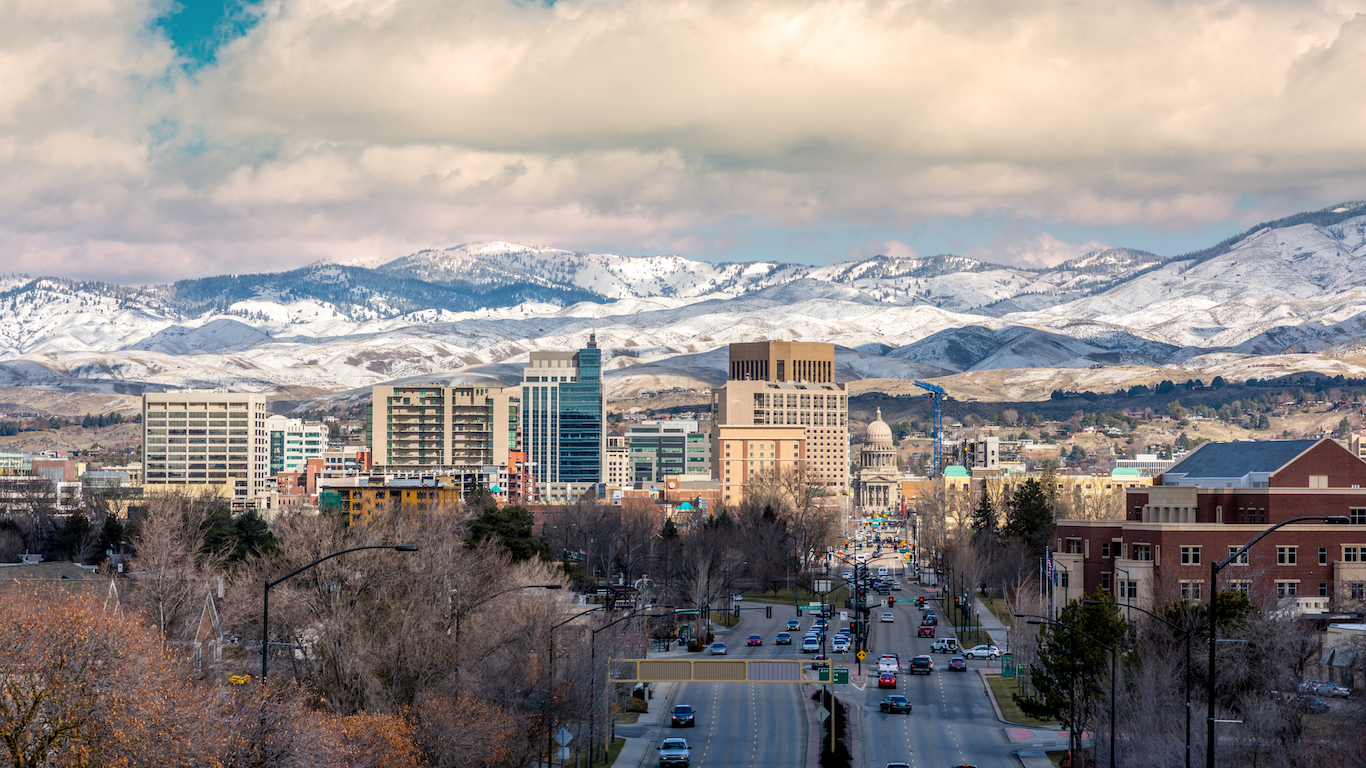
7. Idaho
> TANF-to-poverty ratio: 8 for every 100 poor families
> Median household income: $48,275 (11th lowest)
> Maximum income for initial eligibility: $648 (19th lowest)
> Maximum monthly benefit: $309 (16th lowest)
When TANF was introduced in 1996, the size of each state’s federal grant was determined by its historical spending under the old welfare program. Because Idaho’s spending before 1996 was so low, welfare benefits only covered about 32 poor Idaho families out of every 100 in 1996, well below the comparable 68 per 100 nationwide ratio at the time. Partially because Idaho has broad discretion over TANF, today only eight in 100 poor families in the state directly benefit from TANF cash assistance. On top of the state’s limited TANF assistance, Idaho is also one of 19 states that have not implemented Medicaid expansion.
While many states with TANF programs that help relatively few families in poverty are also home to high concentrations of African Americans, Idaho is an exception. Only 0.5% of the state’s population is black, the second smallest share of any state.
[in-text-ad-2]

6. Arkansas
> TANF-to-poverty ratio: 7 for every 100 poor families
> Median household income: $41,995 (2nd lowest)
> Maximum income for initial eligibility: $278.75 (3rd lowest)
> Maximum monthly benefit: $204 (3rd lowest)
Though TANF was enacted by President Bill Clinton, his home state has one of the least generous welfare policies in the country. Only 6.4% of the $144.3 million spent in Arkansas under the TANF program goes towards cash assistance for needy families. The maximum monthly benefit for a family of three is only $204, the third lowest amount of any state in the country.
While welfare benefits have declined nationwide since 1996, the rate of decline has been far faster in Arkansas. Two-decades ago, 33 in 100 poor Arkansas families benefitted from welfare, about half the comparable 68 per 100 family national ratio. Today, only seven in 100 poor families in the state benefit, roughly a third of the 23 in 100 national proportion.

5. Oklahoma
> TANF-to-poverty ratio: 7 for every 100 poor families
> Median household income: $48,568 (12th lowest)
> Maximum income for initial eligibility: $824 (24th highest)
> Maximum monthly benefit: $292 (14th lowest)
A relatively poor state, Oklahoma’s median annual household income of $48,568 is about $7,000 below the national median. Additionally, 16.1% of state residents live below the poverty line, more than the 14.7% U.S. poverty rate. Despite lower than typical incomes and more widespread financial hardship, Oklahoma has one of the least generous and most restrictive welfare programs of any state. Only about seven in every 100 needy families in the state receive cash assistance from the TANF program, less than a third of the 23 in 100 nationwide TANF-to-poverty ratio. Just across the state’s western border in New Mexico, 22 in 100 poor families receive welfare benefits.
Unlike most states on this list, Oklahoma allocates a majority of welfare funds to core TANF goals intended to directly support needy families. For example, 35.7% of spending under TANF goes to child care-related programs, the fourth largest such share nationwide.
[in-text-ad]

4. Georgia
> TANF-to-poverty ratio: 6 for every 100 poor families
> Median household income: $51,244 (19th lowest)
> Maximum income for initial eligibility: $514 (11th lowest)
> Maximum monthly benefit: $280 (11th lowest)
Only about six in 100 needy families in Georgia receive support from welfare, one of the smallest shares of any states. States with the least generous and most restrictive welfare benefit programs tend to have larger African American populations, and Georgia is no exception. Some 31.3% of Georgia’s population is black, the third largest share of any state. Different political positions on the role of government in supporting low income families also may help explain Georgia’s restrictive welfare program. In addition to the state’s government limited TANF assistance Georgia is one of a minority of states to not implement Medicaid expansion.

3. Texas
> TANF-to-poverty ratio: 5 for every 100 poor families
> Median household income: $55,653 (22nd highest)
> Maximum income for initial eligibility: $401 (7th lowest)
> Maximum monthly benefit: $277 (10th lowest)
Texas has one of the least generous and most restrictive TANF policies of any state in the country. Only 5.8% of the Texas TANF budget is spent in the form of direct cash assistance to needy families, the third smallest share of any state and well below the 24.6% average share nationwide. If welfare recipients in Texas do not meet the state’s established work requirements, TANF benefits can be completely revoked. In neighboring New Mexico, non-compliance is penalized by a reduction in benefits rather than full revocation.
The cash assistance some needy families in Texas do receive is relatively small. The maximum monthly TANF benefit for a family of three in the state is only $277 dollars, lower than in the vast majority of other states.
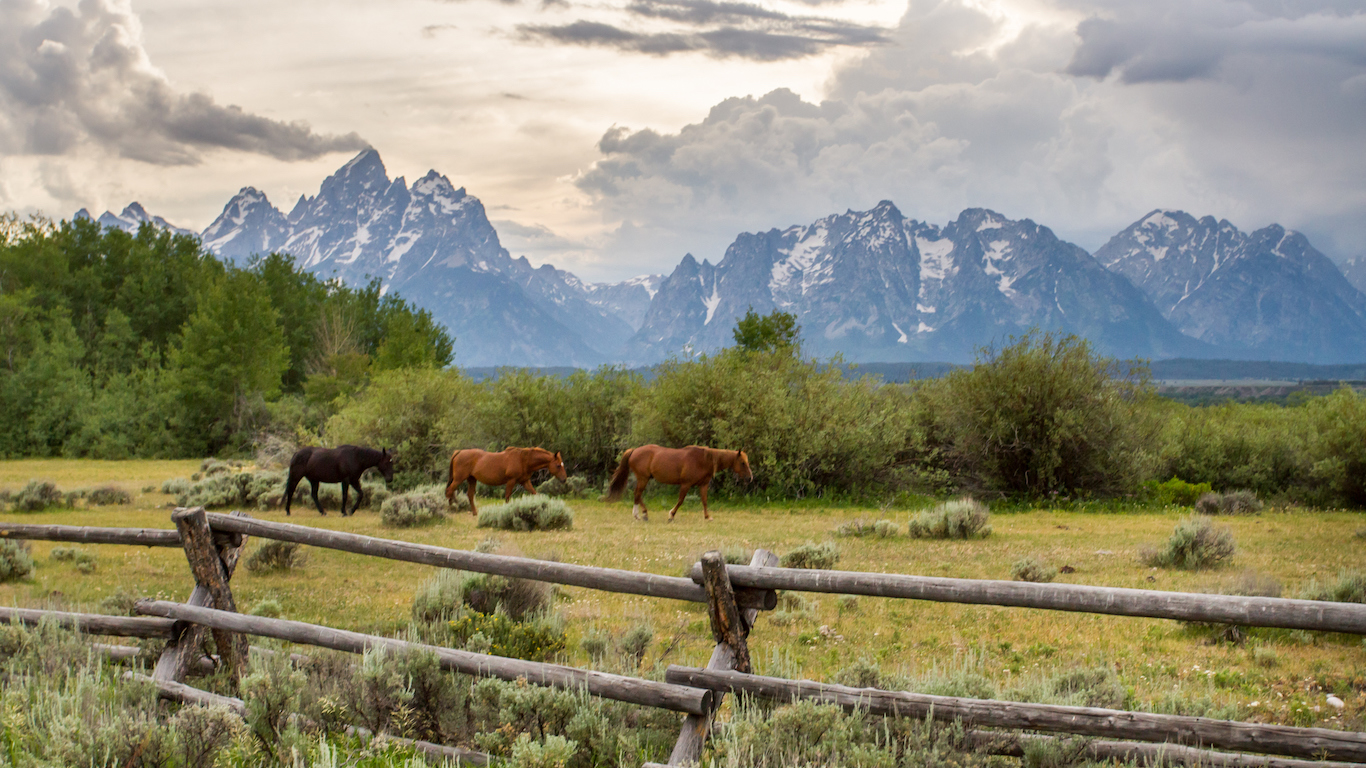
2. Wyoming
> TANF-to-poverty ratio: 5 for every 100 poor families
> Median household income: $60,214 (17th highest)
> Maximum income for initial eligibility: $835 (21st highest)
> Maximum monthly benefit: $635 (6th highest)
Only about five in 100 needy families in Wyoming receive welfare benefits, the second smallest share of any state. Like many states on this list, Wyoming’s less generous and more restrictive TANF policies likely reflect policy makers’ view on the role of government. Wyoming is one of 19 states to choose not to expand Medicaid benefits, which would have provided health care coverage to a larger share of needy families.
While welfare helps relatively few needy families in Wyoming, the benefits available to eligible families are larger than is typical in most states. The maximum monthly benefit for a family of three in Wyoming is $635, more money than in all but five other states.
[in-text-ad-2]
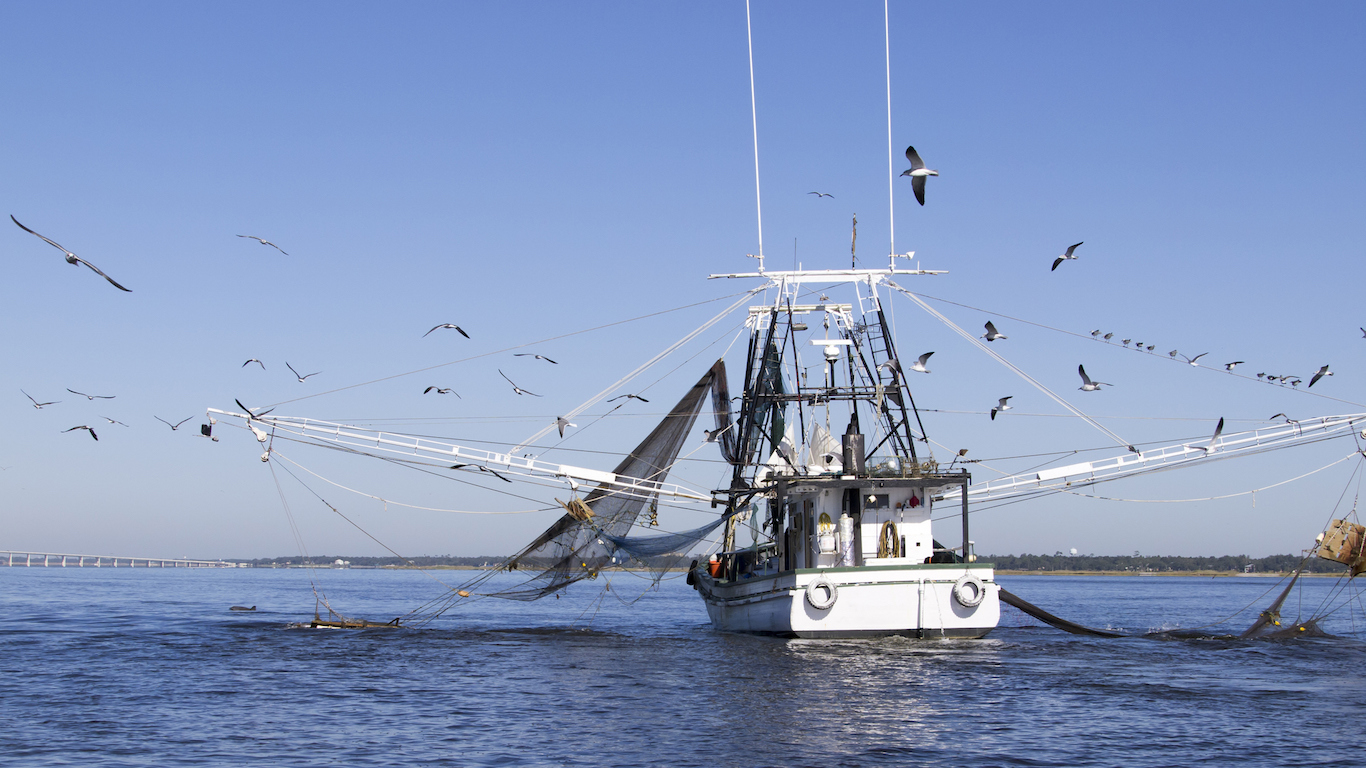
1. Louisiana
> TANF-to-poverty ratio: 4 for every 100 poor families
> Median household income: $45,727 (7th lowest)
> Maximum income for initial eligibility: $360 (4th lowest)
> Maximum monthly benefit: $240 (5th lowest)
With only four families receiving TANF for every 100 in poverty, Louisiana’s cash assistance for needy families is the most limited of all states. As the Urban Institute senior fellow Heather Hahn noted, state officials, who are under no obligation to reduce poverty in their jurisdictions, often threaten to end welfare programs in their constituency. In Louisiana, the low level of cash assistance means the state’s welfare program is all but non existent.
Louisiana’s poverty rate, which at 19.6% is third highest of all states, has changed little since the federal government introduced TANF 20 years ago. Over that time, the state has steadily reduced its investment in welfare and other programs designed to help needy families. Approximately 7,000 Louisiana families received cash benefits in 2015, versus more than 70,000 in 1996. According to a recent analysis by policy think tank the Louisiana Policy Project, state officials have used the welfare dollars to fill holes partially caused by tax cuts.
States Where Welfare Supports the Most Poor Families

10. Connecticut
> TANF-to-poverty ratio: 32 for every 100 poor families
> Median household income: $71,346 (5th highest)
> Maximum income for initial eligibility: $880 (17th highest)
> Maximum monthly benefit: $576 (12th highest)
For every 100 families with children living in poverty in Connecticut, about 32 receive cash welfare benefits, a considerably larger share than the 23 needy families per 100 nationwide. A family of three in the state can get as much as $576 a month in cash assistance, a higher amount than in the vast majority of states. While many states terminate all benefits if work requirements are not met, Connecticut’s policies are slightly more lenient, only reducing benefits by a percentage for first-time non-compliance.
While Connecticut is more generous and less restrictive in its TANF policies than most states, welfare payments assist a far smaller share of families in the state than 20 years ago. In 1996, 82 needy Connecticut families were covered for every 100.
[in-text-ad]

9. Washington
> TANF-to-poverty ratio: 33 for every 100 poor families
> Median household income: $64,129 (10th highest)
> Maximum income for initial eligibility: $954 (15th highest)
> Maximum monthly benefit: $478 (20th highest)
Washington is far less restrictive than most states when it comes to qualifying for welfare assistance. A family of three can have a monthly income of up to $954 and still qualify for cash assistance. In neighboring Idaho, families cannot earn more than $648 and qualify.
The generosity and restrictiveness of a given state’s welfare program can be indicative of the opinions on the role of government in a given state. Suggesting a prevailing belief that government should be used to help those in need, Washington expanded Medicaid to cover more low income individuals. Similarly, like most states on this list, Washington supplements the federal block grant by covering the majority of all welfare spending under the TANF program. Some 57.8% of Washington’s $1.0 billion TANF budget is funded from state coffers, the sixth largest share of any state.

8. Delaware
> TANF-to-poverty ratio: 33 for every 100 poor families
> Median household income: $61,255 (14th highest)
> Maximum income for initial eligibility: $428 (8th lowest)
> Maximum monthly benefit: $338 (18th lowest)
When TANF was enacted in 1996, 99 out of every 100 needy families in Delaware received cash assistance. The federal government has not adjusted the TANF grant for inflation since it was introduced. Partially due to the dwindling resources, the TANF-to-poverty ratio in Delaware has fallen to 33 poor families for every 100, still one of the highest shares of all states.
Despite providing a larger than typical share of needy families with cash assistance, only about 21.4% of Delaware’s $95.0 million total TANF spending goes towards cash payments. The majority — about 51.4% — of Delaware’s TANF budget is allocated to child care subsidies and programs. In comparison, only 16.9% of total TANF spending nationwide goes towards child care.

7. Massachusetts
> TANF-to-poverty ratio: 39 for every 100 poor families
> Median household income: $70,628 (6th highest)
> Maximum income for initial eligibility: $723 (23rd lowest)
> Maximum monthly benefit: $633 (7th highest)
Massachusetts is one of three New England states with one of the nation’s most generous welfare programs. Besides New York, Massachusetts is the only state with no duration limits on welfare cash assistance. In most states, needy families become ineligible for TANF after 60 months. In addition, a family of three in Massachusetts can receive up to $633 a month, a higher ceiling than in all but six states.
While Massachusetts has one of the strongest TANF programs of any state, it is home to relatively little serious financial hardship. The typical household in the state earns $70,628 a year, about $15,000 more than the typical household nationwide, and the state’s 11.5% poverty rate is well below the 14.7% U.S. poverty rate.
[in-text-ad-2]
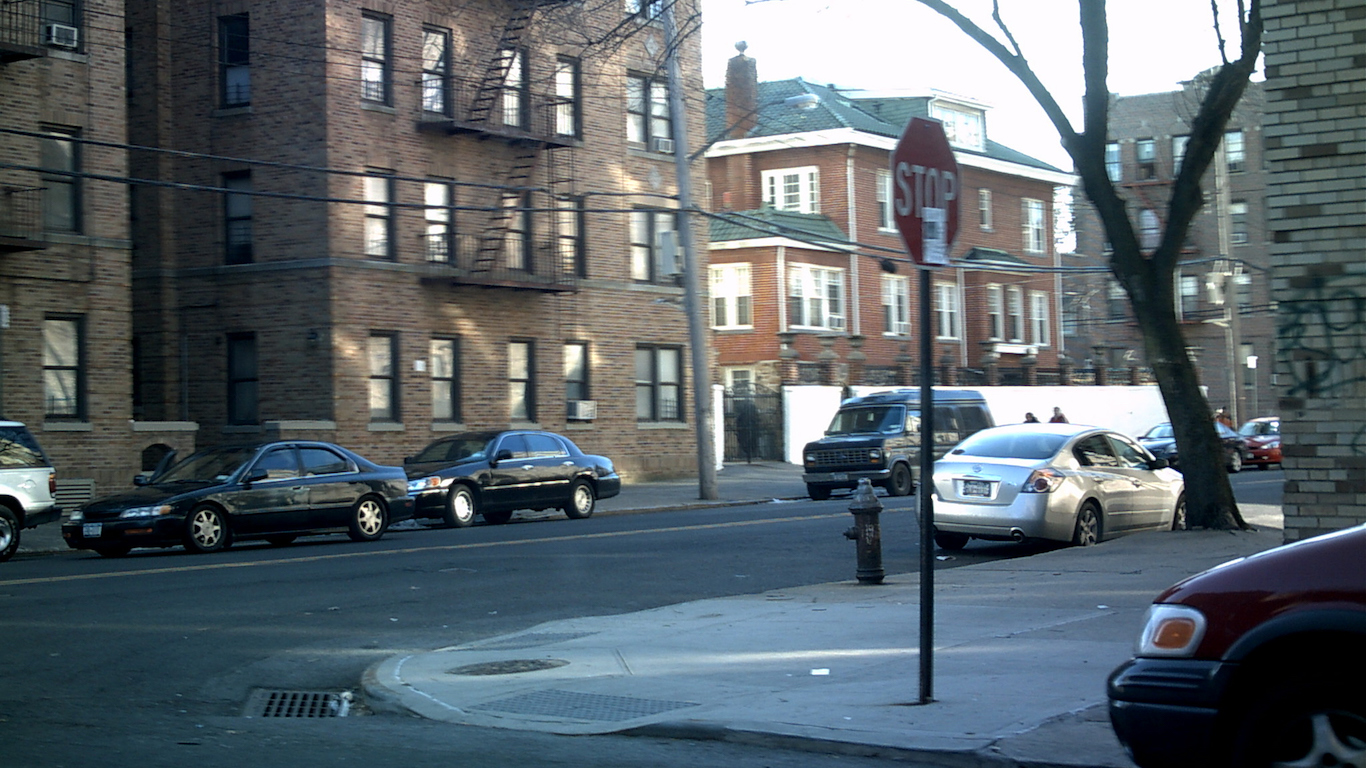
6. New York
> TANF-to-poverty ratio: 40 for every 100 poor families
> Median household income: $60,850 (15th highest)
> Maximum income for initial eligibility: $879 (18th highest)
> Maximum monthly benefit: $789 (2nd highest)
For every 100 needy families in New York state, 40 families receive cash welfare benefits, almost double the corresponding national ratio. The relatively large share is likely due in part to the program’s generosity. While most states have a 60 month lifetime limit on welfare benefits, New York is one of two states with no lifetime limit on cash benefits. Additionally, a New York family of three can receive as much as $789 in cash benefits a month, the most of any state other than Alaska.
While many states with less generous and more restrictive TANF policies tend to have relatively large African American populations, New York does not fit this pattern. Some 15.6% of the state’s population is black, versus 12.7% of people nationwide.

5. Minnesota
> TANF-to-poverty ratio: 41 for every 100 poor families
> Median household income: $63,488 (12th highest)
> Maximum income for initial eligibility: $1,191 (9th highest)
> Maximum monthly benefit: $532 (14th highest)
Like most states where welfare supports the most poor families, Minnesota residents are relatively affluent, and the state uses its own resources to fund most of its welfare program. The typical Minnesota household earns $63,488 annually, the 12th highest median income of all states. The percentage of Minnesotans living in poverty of 10.2% and the percentage of households earning less than $10,000 annually of 4.8% are each among the lowest of all states. Of the approximately $546 million spent on Minnesota’s TANF program, 56% is state funded, the ninth largest share in the country.
[in-text-ad]

4. Oregon
> TANF-to-poverty ratio: 46 for every 100 poor families
> Median household income: $54,148 (25th lowest)
> Maximum income for initial eligibility: $616 (17th lowest)
> Maximum monthly benefit: $506 (16th highest)
The median household income in Oregon of $54,148 a year is not much lower than the national median income of $55,775 a year. Similarly, the state’s poverty rate of 15.4% is not much higher than the national poverty rate of 14.7%. Yet, 18.6% of households in the state receive food stamps, the highest percentage of all states. In contrast, 12.8% of household nationwide rely on food stamps.
As Urban Institute senior fellow Heather Hahn noted in an interview, high reliance on a government subsidy such as SNAP even in a state where welfare is widely distributed partially reflects how low TANF benefits really are. Cash assistance is indispensable for families in financial emergencies, but in Oregon — where the maximum benefit of $506 per month is relatively high — TANF is nowhere near enough to lift a family out of poverty.

3. Hawaii
> TANF-to-poverty ratio: 51 for every 100 poor families
> Median household income: $73,486 (2nd highest)
> Maximum income for initial eligibility: $1,740 (the highest)
> Maximum monthly benefit: $610 (9th highest)
Just over half of poor families in Hawaii receive emergency cash assistance through the state’s TANF program today. While this is well below the 68 needy families receiving assistance out of every 100 nationwide back in 1996 — the year TANF was introduced — it is the third highest TANF-to-poverty ratio in the country today.
Likely due in part to Hawaii’s nation-leading cost of living, the maximum income a family can qualify for cash assistance is also the highest in the country, at $1,740. As is generally the case, relatively generous benefits accompany the high eligibility threshold. Families in need of assistance in Hawaii can receive as much as $610 per month, the ninth highest amount. Hawaii heavily supplements the federal block grant with its own resources, funding 72% of all TANF spending, second highest after only New Hampshire.
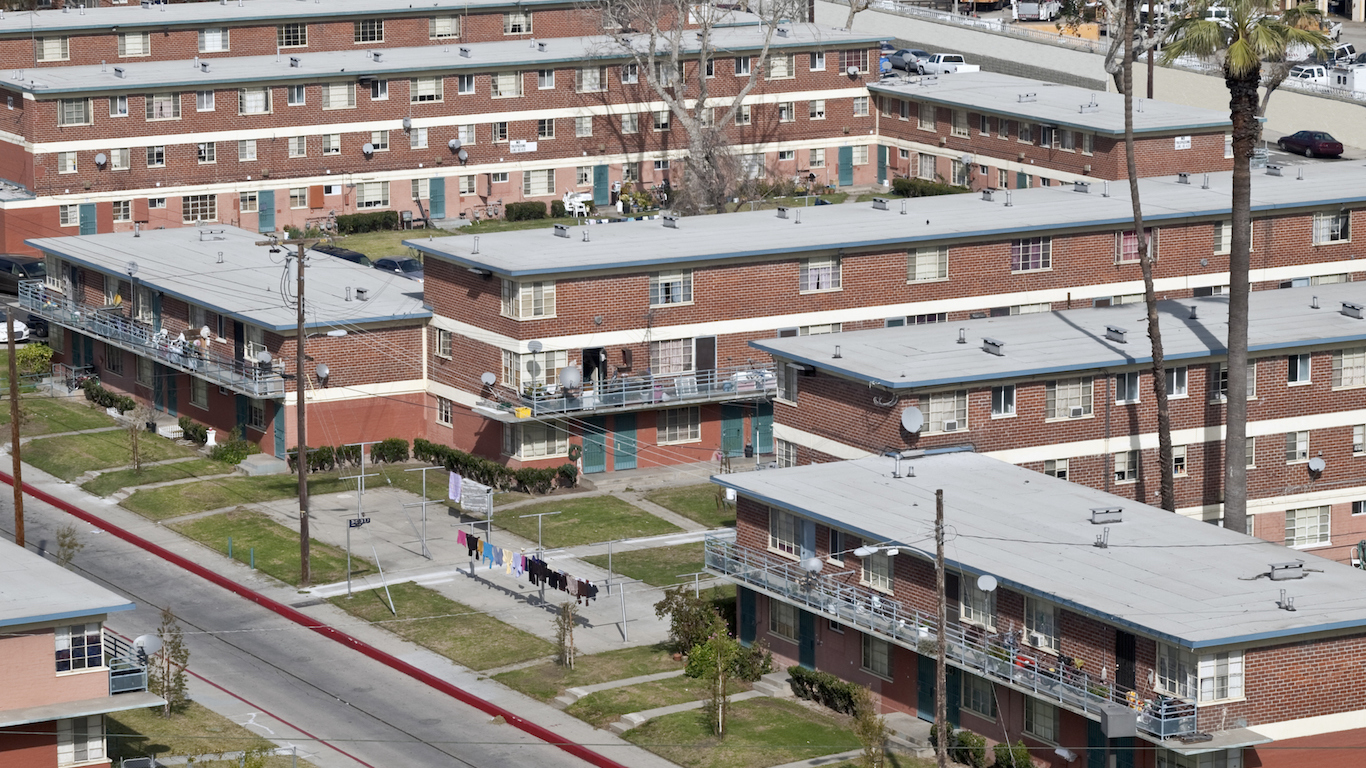
2. California
> TANF-to-poverty ratio: 65 for every 100 poor families
> Median household income: $64,500 (9th highest)
> Maximum income for initial eligibility: $1,315 (5th highest)
> Maximum monthly benefit: $670 (4th highest)
A family of three having trouble making ends meet in California can have income of up to $1,315 per month and qualify for cash assistance of up to $670 per month. Both the income threshold and benefit amount make California’s welfare system one of the nation’s most generous. The state is one of only three where a majority of poor families receive cash assistance.
According to other economic metrics, however, despite the relatively generous government subsidies many California families remain in need. The state’s official poverty rate of 15.3% is in line with the national rate of 14.7%. After accounting for the value of noncash benefits such as nutritional assistance, subsidized housing, contributions toward the cost of medical care, as well as expenses including income taxes, Social Security payroll taxes, childcare and other work-related expenses, the poverty rate is estimated at over 20%. California’s adjusted poverty rate, called the supplemental poverty rate, is the highest in the nation.
[in-text-ad-2]

1. Vermont
> TANF-to-poverty ratio: 78 for every 100 poor families
> Median household income: $56,990 (20th highest)
> Maximum income for initial eligibility: $1,053 (11th highest)
> Maximum monthly benefit: $640 (5th highest)
For every 100 Vermont families who need help making ends meet, 78 receive support under the TANF welfare program — the highest TANF-to-poverty ratio of all states and significantly higher than the nationwide ratio of 23 poor families in every 100 who receive assistance. The ratio of poor families benefiting from the grant declined substantially over the last 20 years in every state except for Oregon. Vermont’s welfare program, however, has not declined substantially from the 1996 proportion of 83 TANF recipients for every 100 needy families. With a maximum monthly benefit of $640 available to families reporting monthly income of as high as $1,053, the state’s welfare system is also one of the nation’s most generous and least restrictive.
Approximately one-third of Vermont’s welfare spending goes to child care, the eighth highest proportion of all states and the largest expenditure category in the state.
Detailed Findings and Methodology:
Congress designed TANF as part of an effort to end welfare. The stated goals are: 1) provide assistance to needy families with children; 2) end dependence on government benefits; 3) prevent out of wedlock pregnancies; and 4) encourage the formation of two parent families. Because the four goals are extremely general, states have broad authority over who gets TANF assistance, under what conditions, and the form of that assistance. As a result, TANF benefits are often used more broadly by states than the core goals of supporting needy families with temporary cash assistance.
“States got to set the rules about who is eligible for what, and what rules they need to follow to receive [cash assistance], and that’s where we see this great variability in state policy,” said Hahn.
States using TANF to support more needy families have relatively fewer restrictions and more generous benefits, while the opposite is generally true in states with the lowest TANF-to-poverty ratios. In Louisiana, where just four in every 100 poor families receive TANF, a family of three earning more than $360 per month would not qualify for the modest $240 maximum monthly benefit.
By contrast, families earning $600 or more per month in all but two of the 10 top states can qualify for relatively generous monthly benefits of at least $500. In four of the 10 top states the maximum income for eligibility is over $1,000.
Approximately half of TANF spending goes to tax credits, prekindergarten education, child welfare, and other services not limited to low-income families. The welfare spending categories of basic cash assistance, work activities, work support, and childcare — expenditures meeting the core goals of TANF — account for the remaining half of welfare spending across the nation.
These core categories account for most of spending under the TANF program in seven of the 10 states where welfare supports the most poor families, but only in two of the 10 states where welfare supports the fewest poor families.
The Urban Institute found that while TANF policies are technically race neutral, meaning that everybody regardless of race is subject to the same rules, states with less generous and more restrictive welfare policies tend to have larger African American populations, all else equal. In fact, the majority of African Americans live in states that provide TANF cash assistance to no more than 19 families out of every 100 families living in poverty.
To identify the states where welfare supports the fewest (and most) poor families, 24/7 Wall St. reviewed the TANF-to-poverty ratio — which measures the number of families receiving benefits for every 100 families living in poverty — in every state from the Urban Institute. In its May 2017 report, “Why Does Cash Welfare Depend on Where You Live,” the policy think tank analyzed data from the government and a variety of other sources. Maximum monthly income for initial eligibility and the maximum monthly benefit also came from the Urban Institute. The percentage of people living in poverty, the median household income, the percentage of households receiving food stamps, and racial composition in each state came from the U.S. Census Bureau’s 2015 American Community Survey. The Supplemental Poverty Measure is a three-year average through 2015 and came from the U.S. Census Bureau.
Retirement planning doesn’t have to feel overwhelming. The key is finding expert guidance—and SmartAsset’s simple quiz makes it easier than ever for you to connect with a vetted financial advisor.
Here’s how it works:
Why wait? Start building the retirement you’ve always dreamed of. Click here to get started today!
Thank you for reading! Have some feedback for us?
Contact the 24/7 Wall St. editorial team.